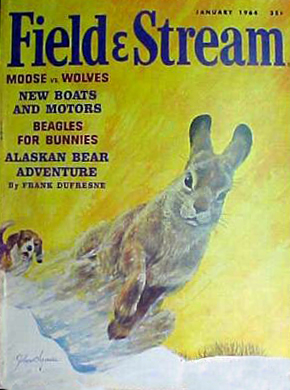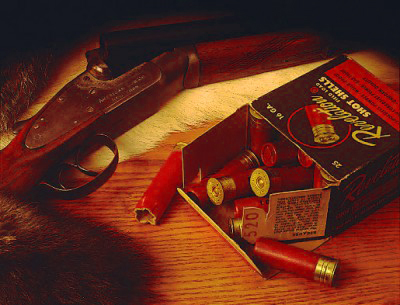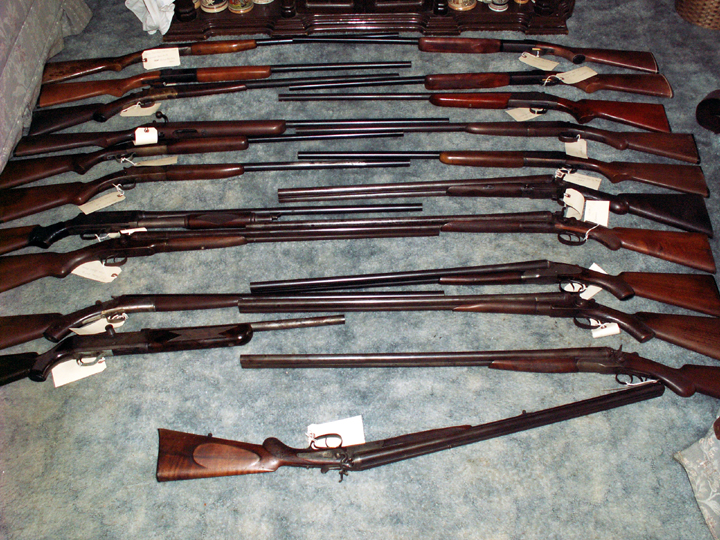THE QUEST
The older you get, the more you miss your youth; but since the older you get, usually the more money you have, the more you have a chance to buy it back. I've been doing so with a fair degree of success with respect to my guns. I'm slowly rebuilding the accumulation of stuff-I won't call it a "collection"-that I had as a callow stripling. Some of the guns have never left my hands, but others did, thanks to Youth's lack of money or simply not realizing they had a value greater than what the book said they're worth.
 The first gun I ever posessed was a Montgomery Ward's Western Field Model 10 single-shot shotgun, in 20 gauge. It was really a Stevens 94Y, the youth version, sold under a private label brand. Savage/Stevens made umpteen gazillion of these little single shots. Many were sold under their own name, but they were also made in huge numbers for bulk purchasers.
The first gun I ever posessed was a Montgomery Ward's Western Field Model 10 single-shot shotgun, in 20 gauge. It was really a Stevens 94Y, the youth version, sold under a private label brand. Savage/Stevens made umpteen gazillion of these little single shots. Many were sold under their own name, but they were also made in huge numbers for bulk purchasers.
Sears Roebuck and Montgomery Ward's, the two big mail-order houses, were major buyers of private label guns. Savage was one of the biggest makers, but Mossberg, High-Standard, and even
Such guns, especially shotguns and .22 rifles, were tools like shovels or wire cutters, and marketed the same way. Cheap, durable, useful for shooting groundhogs in the garden or the odd deer in the orchard. Something to carry on the combine or behind the pick-up truck seat, or to stash behind the door of the kitchen in case some crows needed to be stopped from raiding the corn patch in Mama's vegetable garden. Untold numbers were sold to farmers, ranchers, homeowners and anyone else needing a utility gun through mail order catalogs. These halcyon years ended with the passage of the never-sufficiently-to-be-cursed Gun Control Act of 1968, when the really hot and heavy demonization of guns and gun owners and their expulsion from the mainstream of American life began in earnest. Before 1968 guns were very much in the mainstream: you could buy a brand new utility-grade shotgun at any rural farm supply, hardware or general store. Not only was it a perfectly normal thing in rural communities, it wasn't so rare in big cities. Most urban department stores with sporting goods departments sold guns. In my teenage years they were sold in Macy's on
In late 1961 my father bought a country property from an elderly couple who were moving to a retirement community, and he bought everything: house, land and all contents were included in the sale. Among the "contents" was the Model 10, stuck behind a door in the kitchen. The owner had bought it in the 1940's, to keep rabbits and woodchucks out of his garden. I was 13 at the time, and desperately waiting to be 14 so I could get a New York State hunting license for small game (for big game, you had to be 16). On my first trip to the new house I spotted that shotgun, immediately appropriated it, and began planning to use it the following Fall of 1962, when I would be licensed.

 In 1962 if a 13-year-old wanted shotgun shells the only thing he needed to buy them—quite legally—was the money to pay for them. There was a small general store about 2 miles from our house which, like every other general store in the state, sold shotgun shells. That Summer I persuaded my father to drop me off as we passed through the village on the way to the house for the weekend. I walked in, plunked down my money, and emerged with a box of Western Super-X 2-3/4" #6's. Long hours poring over Field & Stream had convinced me #6's were the shot size for squirrels, which were to be my first prey. The shells came in a red and yellow box and were the bright red I still associate with
In 1962 if a 13-year-old wanted shotgun shells the only thing he needed to buy them—quite legally—was the money to pay for them. There was a small general store about 2 miles from our house which, like every other general store in the state, sold shotgun shells. That Summer I persuaded my father to drop me off as we passed through the village on the way to the house for the weekend. I walked in, plunked down my money, and emerged with a box of Western Super-X 2-3/4" #6's. Long hours poring over Field & Stream had convinced me #6's were the shot size for squirrels, which were to be my first prey. The shells came in a red and yellow box and were the bright red I still associate with
 Now, I know all about the superiority of plastic shells: their incredible water-tightness, their resistance to
Now, I know all about the superiority of plastic shells: their incredible water-tightness, their resistance to  swelling, and all the rest of their advantages, and I admit them. Plastic shells are better in every way, in terms of performance and durability in use. But they don't smell like paper shells, they don't feel like paper shells, and they will never, in my heart, be real shotgun shells. I'm confident that God still uses paper hulls.
swelling, and all the rest of their advantages, and I admit them. Plastic shells are better in every way, in terms of performance and durability in use. But they don't smell like paper shells, they don't feel like paper shells, and they will never, in my heart, be real shotgun shells. I'm confident that God still uses paper hulls.
I hoofed it home from the store with my prize, laying plans for the devastation of the local squirrel population that Autumn. My father's property had about 50-odd acres of mature trees, mostly oaks with an interspersing of pine trees. This was perfect squirrel territory, and they were there, all right. I had actually managed to kill a squirrel in our backyard in Da Bronx using my highly-illegal home-made slingshot, so I had some idea of what to do when I made a kill. It remained to make a kill.
 No African safari was as meticulously organized as my first trip into the woods with a real gun. I sweated through the required New York Hunter Safety course (literally: it was held in an incredibly stuffy and airless room over a gun shop in
No African safari was as meticulously organized as my first trip into the woods with a real gun. I sweated through the required New York Hunter Safety course (literally: it was held in an incredibly stuffy and airless room over a gun shop in
Over the years that gun went on to be used for other small game, but eventually it was relegated to second-string status, replaced by newer and better guns. In my college years, heedless of what it really represented, I traded it off for a cute little FN-made .25 automatic. Almost as soon as I made the trade I began to wonder if it had been a good idea. Eventually, I realized it wasn't, but by then it was too late, and I couldn't get my Western Field back. I know exactly where that shotgun is now, but it's out of my reach and I will never lay eyes on it again.
So began The Quest, many years ago, for another like it. You would think this would be a simple thing to do, finding a Stevens 94 shotgun. They certainly aren't rare guns. But Stevens made innumerable variations with different stocks, different locking systems, different barrel lengths, different styles of wood, and so forth. You could easily fill a medium-sized museum with Stevens 94 variants; when you include the dozen or so private label guns, there are hundreds of possible variations. Given their nature and the way they were used, not many of them have survived intact: fifty-plus years of wear and tear, and often outright abuse, take their toll. Yes, Stevens 94's are common, but most of them are different than the one I wanted, and nearly all of them are beaten to pieces.
Still, I tried, and have tried for years. I constantly watch the gun auction sites for a duplicate, searching under the terms "Stevens 94" and "Western Field." I've come close; a few years back I managed to find another variant sold by Wards, under the name "Hercules," a pre-World War 2 line. It's very, very much like my old gun, but it doesn't feel quite right. Worse, it's been re-blued and the stock refinished with that God-awful bowling-pin varnish that's bright and shiny and hard as a BATF agent's heart.
Last Saturday I went to a local gun auction. Lot #1 was...a Western Field Model 10! I didn't get my hopes up: it wasn't likely to be a 20 gauge. The great majority of them were 12's and I didn't want a 12. They're too large and have brutal recoil; the older small gauge 94's were built on a slimmer and more graceful frame. But...
The bore needed cleaning but it wasn't scored or pitted; the wood was in surprisingly good shape, with only one or two very tiny dings, nothing serious. A lot of old farm guns have stocks that have been broken at the wrist and repaired with everything  from duct tape to baling wire (a new stock would have cost almost as much as a whole new gun). But
from duct tape to baling wire (a new stock would have cost almost as much as a whole new gun). But
So it proved. After an agonizing 2 hours of selling old books, ammunition, and reloading equipment, the auctioneer finally got to the Main Event. Less than 2 minutes after starting the bids on
I'm always amazed at the quality of the wood on old guns: before about 1960, even a cheap store-brand utility gun was fitted with a decent walnut stock and properly blued: the "walnut-finish hardwood" stock of today didn't exist. Furthermore, manufacturers understood that metal had to be polished before bluing to get proper results.
My first gun had a proper walnut stock and fore-end, so does this one. It has nothing in the way of figure, but it's solid, sound, and has nice straight grain with "depth" to it. The fore-end is the same. After a thorough wash in hot soapy water to remove the grime, a light sanding with 220-grit paper, and a coat of stain to make the color uniform, I applied a light finish of Birchwood-Casey "Tru-Oil," and the wood looks amazingly good. Any Marlin Model 39 Deluxe would be proud to wear that stock.
There is no rust in the action, everything is tight, the spring-loaded ejector throws a shell over my right shoulder just like the old one did. The case hardening colors on the receiver are pretty much gone, but the blue on the barrel is almost wholly intact and unmarred by scratches or wear. There's a discreet "94B" stamped into the receiver. The Model 94 per se was made between 1939 and 1969 (later versions have different model numbers). My guess is this gun is pre-World War 2, and certainly pre-1955. It has no serial number, of course. I have even found some 16-gauge #6 shotshells. They're.well.plastic, but I can live with that.
It isn't absolutely identical to my old one: the barrel is 30" and I believe my old 20 was 26" for one thing, and of course there is the different gauge. But it does have the red rubber recoil pad with T-shaped slots mine had, also in good shape. It looks and feels just like the old one did, and until I run across one like it in 20 gauge, this one will do.
The Quest continues. I'm getting closer each time, if not to my lost youth, at least to a few such artifacts that allow me to remember, for at least a few minutes, what it was like to be a kid who finds a real treasure behind a kitchen door.
UPDATE: DECEMBER 31, 2011
Sometimes things are right under your nose and you don't see them. I was playing with my toys one day and it occurred to me that the stock and forearm on that 16-gauge Wards Model 10 were identical to the one on my childhood gun. The 94Y had a 26-inch barrel, not the standard 28-inch barrel, nor the 30-inch one on the 16 gauge gun I already had...but that Hercules shotgun's barrel was...let's see, get the tape measure...26 inches!
Out came the screwdriver, and off came both stocks. I swapped them out and...a perfect fit. The 16 gauge, wearing the garishly refinished stock was given to a worthy kid, and The Quest was over. I had my "replacement" 94Y after all. Now, I need a squirrel or two.
| HUNTING | GUNS | DOGS |
| FISHING & BOATING | TRIP REPORTS | MISCELLANEOUS ESSAYS |
| CONTRIBUTIONS FROM OTHER WRITERS|
| RECIPES |POLITICS |
